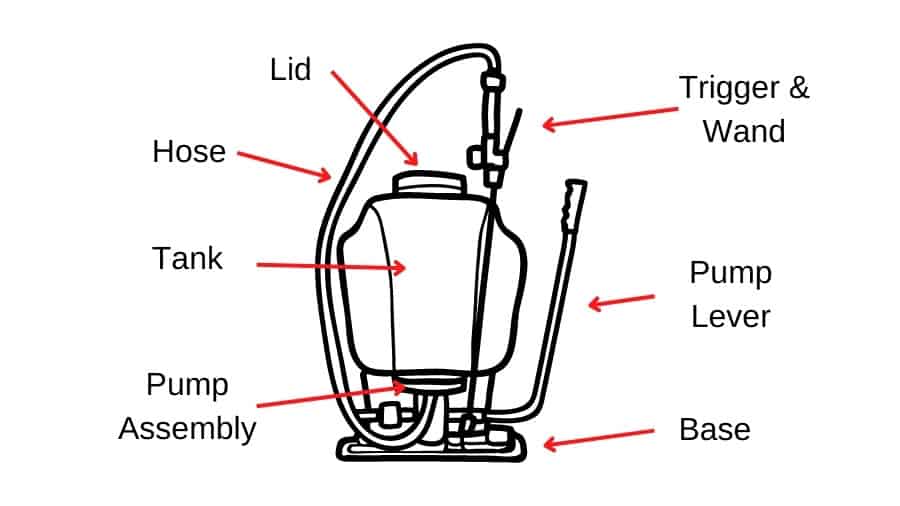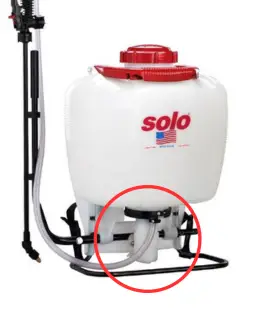I can remember wanting to use my dad’s backpack sprayer when I was a kid. It was such an intriguing piece of equipment and I thought it had to be fun to use. Little did I know that it was hard work, but a good backpack sprayer is still a valuable tool for farmers, lawn care pros, contractors, or DIYers.
The aim of this guide is to determine what to look for when buying a backpack sprayer and what type of backpack sprayer will be the best for your application.
What is a Backpack Sprayer?
If you are reading this then you are likely at least a little familiar with backpack sprayers. But, for the purposes of this post, we should at least be sure we are all on the same page with what we consider a backpack sprayer.
A backpack sprayer is a term that refers to any hand or electric-powered sprayer that is carried on your back during use. There are several different brands and variations of backpack sprayers. A backpack sprayer has many similarities to hand pump sprayers and ATV/UTV sprayers (commonly called “spot sprayers”).
The Basic Components of a Backpack Sprayer
Generally, every backpack sprayer will consist of the same basic components. You will find that there are several variations and design differences between different manufacturers. Variations exist in the different types of materials used to construct the sprayer, the type of pump assembly, the tank size, and more.
These are the basic parts of a backpack sprayer:
- Tank
- Lid
- Hose
- Trigger & Wand
- Pump Lever
- Pump Assembly
- Base

Backpack Sprayer Pros & Cons
Pros
- More efficient than a hand pump sprayer because you don’t stop to pump.
- More capacity than hand pump sprayers means fewer refills.
- Generally lower cost than a boom sprayer or ATV spot sprayer.
- Less downtime than boom and spot sprayers.
- More consistent spray pattern (Electric models)
- Less bending over than with a hand sprayer.
Cons
- Greater cost than hand pump sprayers.
- Heavier than a hand pump sprayer.
- Can be hard for one person to put on their back.
- Greater potential or leaks onto your body than with other sprayer types.
What are The Different Types of Backpack Sprayers?
As shown above, the basics of the different backpack sprayers are very similar. However, there are differences. There are several different tank designs, strap types, handles, spray wands, agitation, etc. But the variation that will affect your backpack sprayer’s performance the most is the type of pump assembly that is used.
There are three pump types commonly used in backpack sprayers: manual, electric, and gas-powered. Manual-style backpack sprayers are available in two styles: piston and diaphragm.
The piston-type backpack sprayer is shown below on the left and the diaphragm-type is on the right. You can see the difference in the appearance of the two types of pump assembly at the bottom.
Piston

Diaphragm

Piston Vs Diaphragm Backpack Sprayer
The piston-style backpack sprayer is capable of producing a higher PSI than its diaphragm-style counterpart. This means that all things being equal, you can achieve a greater spray distance and spray for a longer period before needing to pump the lever more.
The diaphragm-style backpack sprayer may not produce as much pressure as the piston-type backpack sprayer, but it does have one distinct advantage. Because of the flexible nature of the diaphragm, there is clearance within the pump assembly that will tolerate solid material. This means that dirt, debris, sand, or undissolved particles in your water are less likely to cause damage.
A piston-style sprayer does not tolerate solid particles well. There is no clearance and solid material will be too abrasive. This makes a diaphragm pump better suited for use with dry products that you dissolve in water when mixing your spray solution.
This is not the only benefit of the diaphragm-type sprayer that I found when comparing the two types. I found that a diaphragm pump offers more “forgiveness” when things get sticky inside the pump. Meaning when you have residue build-up from Round-up or other chemicals “gumming up” your pump, the diaphragm pump still operates while the piston style can be hard to pump and this leads to damage.
In an ideal scenario, you would triple-rinse the sprayer after each use and use a tank cleaner to rinse out any leftover chemical residue. I will be the first to admit that I don’t always do this, but I try each time to rinse the entire sprayer and pump fresh water through the system when I am done.
You can find more information about fixing and cleaning your backpack sprayers here:
Electric-Powered Backpack Sprayer

The electric-powered backpack sprayer options have grown in recent years. New lighter-weight batteries make it more convenient to use electric pumps on backpack sprayers. The electric backpack sprayer has some major advantages, however, you are going to pay more for those benefits.
The first major advantage that an electric sprayer provides is consistency. The electronic pump will produce and maintain the same pressure while a manual backpack sprayer will slowly lose pressure as you spray unless you are constantly pumping the lever.
This consistency is important because it results in more even coverage of your spray solution. There is still some variance in coverage because you still have some inconsistency in walking speed and how to move the spray wand, but this ensures operating pressure is not a variable.
More even coverage means better results from the product you apply. No areas that are undertreated and may have to be covered again.
The second main advantage you get from an electric backpack sprayer is less fatigue. Without the need to pump a lever to keep spraying, your progress is not hindered by the physical limits on your arm and shoulder. After using a backpack sprayer for about an hour, I can feel strain and fatigue in my arm.
Electronic Backpack Sprayer Benefits:
- More Consistent application
- No fatigue from pumping
Gas-Engine Powered Backpack Sprayers
Like an electric backpack sprayer, a gas engine-powered sprayer provides greater consistency and greater potential spray distance. They do have the advantage of potentially higher spray pressure than electric backpack sprayers. This means greater spray distance or “throw”.
This makes a gas engine backpack sprayer the best option for jobs like spraying small trees or cleaning buildings.
Some potential drawbacks are weight, maintenance, and noise. Gas-engine backpack sprayers are the heaviest type of backpack sprayer. Empty they can weigh 25+ pounds. Engines are typically noisier than electric sprayers, and there is more maintenance required to maintain a small engine compared to an electric-style backpack sprayer.
The Benefits of a Backpack Sprayer
A backpack sprayer is very similar to a hand pump sprayer. The method of “pumping up” the sprayer is essentially the same. A backpack sprayer is an upgrade over a hand pump sprayer for a few main reasons: the capacity of the tank is larger, you do not have to stop to “pump” the lever, and it is more hands-free than a pump sprayer.
I have used both backpack sprayers and hand sprayers for years. I find the backpack sprayer to be much more efficient in the right scenario.
Despite being heavier than a hand sprayer, a backpack sprayer can be easier on your back and less tiring. You don’t have to carry the sprayer with one hand and stop to set the sprayer on the ground each time to “pump it back up”.
So assuming you are physically capable of carrying a backpack sprayer filled with liquid, you can spray more efficiently and for longer periods of time without getting worn out.
When you consider electric-powered versions of backpack sprayers, there are even more advantages over a hand pump sprayer. Consistent flow and sprayer pattern. Greater potential spray distance, and less fatigue than a hand pump or manual backpack sprayer.
What Can a Backpack Sprayer Be Used For?
A backpack sprayer can be used for many different tasks. From lawn care to cleaning, there are backpack sprayers designed to work with chemicals, soaps, sealers, and more.
- Apply herbicides to lawns or turf
- Fertilizing lawns or gardens
- Spraying homes for insects, both indoor and outdoor applications
- Spraying disinfectant
- Cleaning exteriors of buildings
- Dust abatement
- Watering plants
Most Critical Factors to Consider When Selecting a Backpack Sprayer
If you are looking at purchasing a sprayer for the first time or just wanting to upgrade your current one, these are the most important factors to consider:
Tank Size
When it comes to the tank size of a backpack sprayer, there are not many options to choose from. But it is still an important factor to consider. 4-gallon is the most common size but there are some 2.5 and 3-gallon sizes available, and even some 4.5 or 5-gallon options.
The difference may not seem like a lot but we are talking 20-25 percent difference in capacity, and that can mean 20-25 percent more area sprayed before needing to refill. This can add up, especially for professionals who may spray tens of thousands of square feet in a day.
If you are comfortable with the extra weight of a fully loaded 5-gallon backpack sprayer then it is probably worth considering the larger size in order to be more efficient and productive.
How Far Can It Spray?
Spray distance is a complicated thing to calculate. Many backpack sprayers will claim a maximum spray distance or horizontal throw. This is based on the maximum pressure and nozzle size that is included with that sprayer. It may be achievable but there are many variables, and the conditions need to be just right.
If your spray tasks will require as much spray distance or spray height as possible, you should look for the backpack sprayer that will offer the highest pressure. Then, you can try out different-sized nozzles to get the most distance possible.
Electronic sprayers will help with spray distance. Some of the electric backpack sprayers reach pressures over 100 PSI. As mentioned earlier, they provide consistent pressure. When spray distance will be important, an electronic sprayer will keep you from constantly needing to pump the lever to get the pressure you need for maximum distance.
Related: How Far Will a Pump Sprayer Spray?
Electric vs. Manual
As mentioned above, an electric backpack sprayer will provide more consistent spray as well as keep you from developing a sore arm from the constant pumping. However, the electric sprayers will cost you more.
With a manual sprayer, you do lose the consistency however, you don’t have to worry nearly as much about downtime. There are no batteries to keep charged or electric pumps that may go bad.
Piston vs Diaphragm
If you recall, there are two different types of manual backpack sprayers. If decide against an electric version, you should consider the pros and cons of both the piston and diaphragm-style backpack sprayer.
Benefits of Piston Type Backpack Sprayer:
- Longer spray time between pumping
- Farther potential spray distance
Benefits of a Diaphragm-Type Backpack Sprayer:
- Handles solid particles
- More resilient to residue build-up
Comfort
When using a backpack sprayer you play a huge part in the performance of the sprayer. If the sprayer is too heavy or uncomfortable, your efficiency will decrease.
When looking for a backpack sprayer, examine the straps and try them out if possible. The contour of the tank and the way the straps connect to the tank can make a significant difference.
When considering manual backpack sprayers, the placement of the lever in relation to your arm/body is going to be different for everyone. Sprayers are made as a “one size fits all” but they will be easier to operate for some individuals.
Suggested Backpack Sprayers
Top Rated Electric: FlowZone Typhoon Battery Powered Backpack Sprayer
Features:
- Durable & comfortable vest-style shoulder straps
- Adjustable pressure settings
- Can spray over 30 feet vertically or horizontally
- 1-Year warranty
Manual Backpack Sprayer: Solo 475 Diaphragm Backpack Sprayer
Features:
- Affordable
- A resilient diaphragm pump assembly
- The spray wand will work with Teejet Sprayer nozzles
Final Thoughts
There are many things to consider when selecting a backpack sprayer. The main things to consider are comfort, pump style, and quality. You can find a quality sprayer for residential use without spending a ton of money. Solo backpack sprayers have worked well for me for many years. If you invest in a sprayer and maintain it properly you can expect it to last longer.
Always inspect and test a new backpack sprayer with water to ensure it has no defects and reach out to the manufacturer if there is a problem.
Read More:



